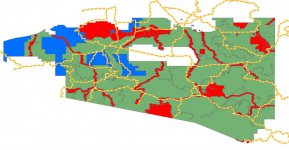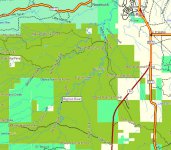Absolutely true. "In GENERAL". If you don't know which forest you are in, which roads are considered "plowed", which management area you are in (wilderness, etc), then in general, the safe bet is sticking to roads and trails and the safer bet is to stick to designated roads and trails.
Very restrictive is the HMNF:
Huron Manistee National Forest:
https://www.fs.usda.gov/Internet/FSE_DOCUMENTS/stelprd3821078.pdf
Prohibited:
Using a motor vehicle, snowmobile, motorcycle, or OHV on Forest roads unless that road or portion of road is designated open to that type of vehicle.
To possess or use a motor vehicle, snowmobile, motorcycle, or OHV off Forest roads, off trail, into, across, or over forestland, wetlands, streams or beaches unless the area is designated open.
Less Restrictive is the Ottawa, but you still have to know multiple exceptions and your location:
Ottawa National Forest:
https://www.fs.usda.gov/Internet/FSE_DOCUMENTS/stelprd3833604.pdf
Snowmobiles are prohibited in designated wildernesses, Sylvania Perimeter Area, and on plowed Forest System Roads. In Semi-primitive Non-motorized Management Areas and Wild and Scenic Rivers Corridors snowmobiling is limited to designated trails.
Beginning March 1, the area of the Ottawa National Forest south of M-28 and east of Highway M-64, is closed to cross-country snowmobile use.
Hiawatha has nothing posted for reference other than their 2006 forest plan.
Hiawatha National Forest
https://www.fs.usda.gov/Internet/FSE_DOCUMENTS/stelprdb5106341.pdf
Forest roads within motorized ROS objectives will be open to snowmobile use unless designated closed.
Cross country snowmobile use is generally allowed within motorized ROS classes unless prohibitions or restrictions are needed for resource protection to meet management objectives.
CNNF is pretty restrictive
Chequamegon - Nicolet National Forest
https://www.fs.usda.gov/detail/cnnf/notices/?cid=STELPRDB5182020
Using a snowmobile on National Forest System roads unless such road is unplowed and has a snow accumulation exceeding four inches is prohibited. 36 CFR 261.54(a).
Using snowmobile on a National Forest System trail is prohibited unless designated 'open" for such use by posting.
It is prohibited to possess or use a motor vehicle off National Forest System roads. (cross country travel)
Superior is fairly restrictive (lots of "which area are you in" caveats):
Superior National Forest
https://www.fs.usda.gov/Internet/FSE_DOCUMENTS/stelprdb5111683.pdf
It is prohibited to use a snowmobile on unplowed Forest System roads within the following management areas: Semi-primitive non-motorized Recreation; Research Natural Areas; Candidate Research Natural Areas; Unique Biological Areas; and wild segments of Eligible Wild, Scenic, and Recreational Rivers.
It is prohibited to use snowmobiles on any plowed National Forest System road, except those listed in Exhibit A and shown on Exhibits B-1, C and D.
It is prohibited to possess or use a snowmobile off National Forest System roads within the following management areas: Semi-primitive non-motorized Recreation; Research Natural Areas; Candidate Research Natural Areas; Unique Biological Areas; and wild segments of Eligible Wild, Scenic, and Recreational Rivers.





